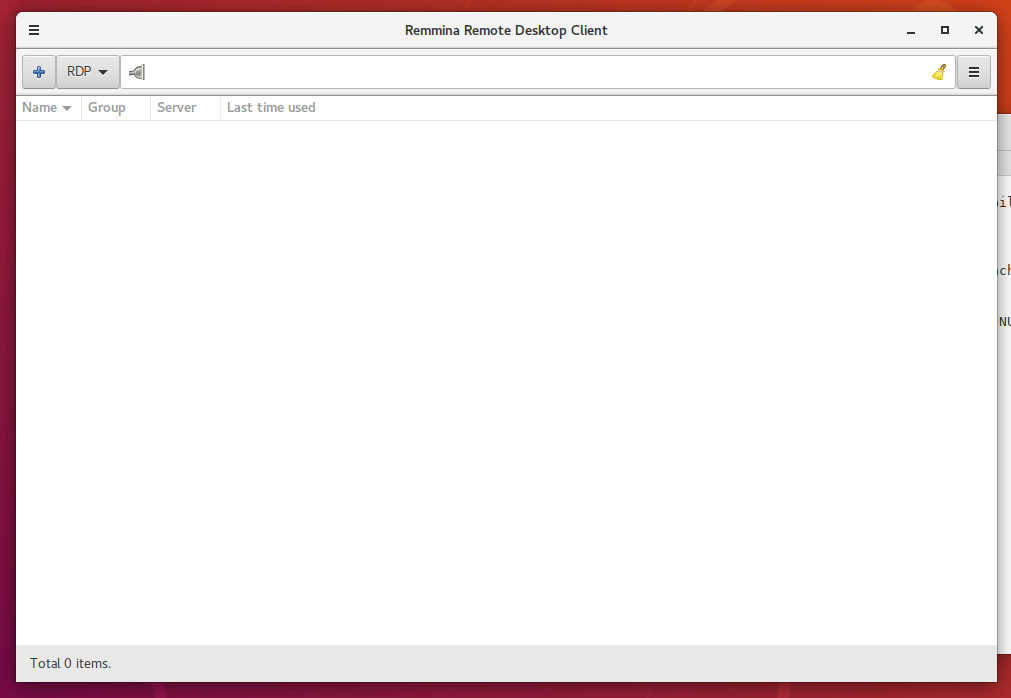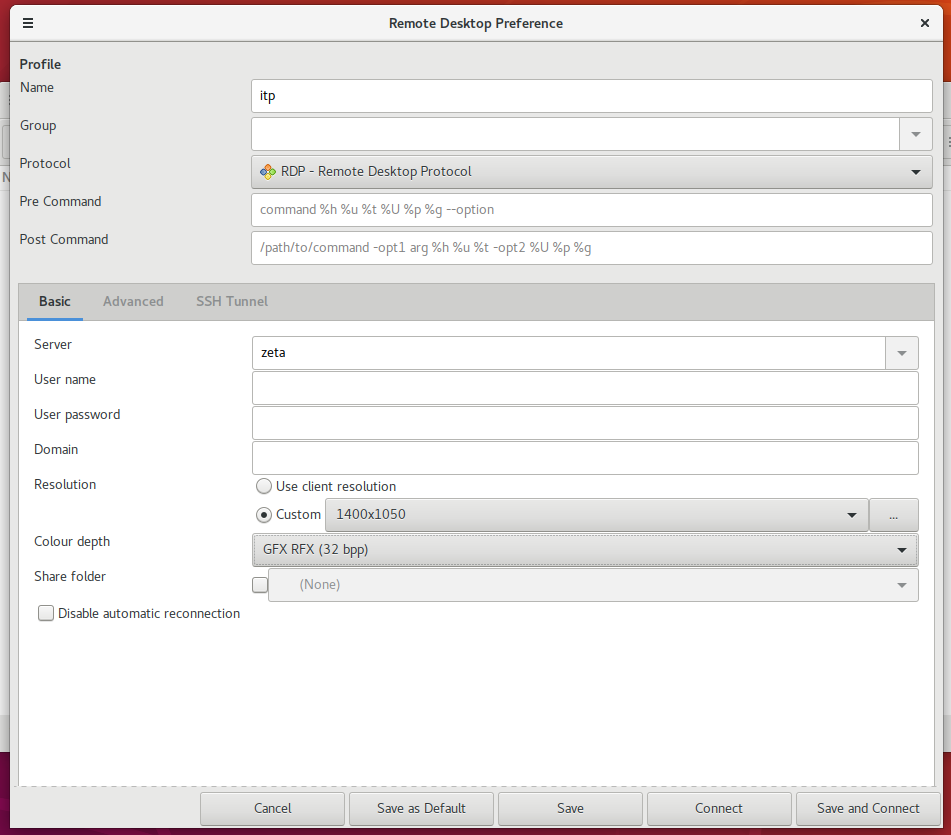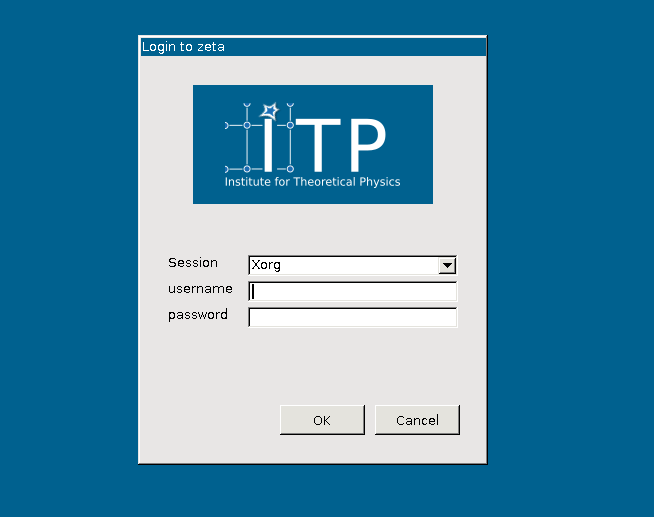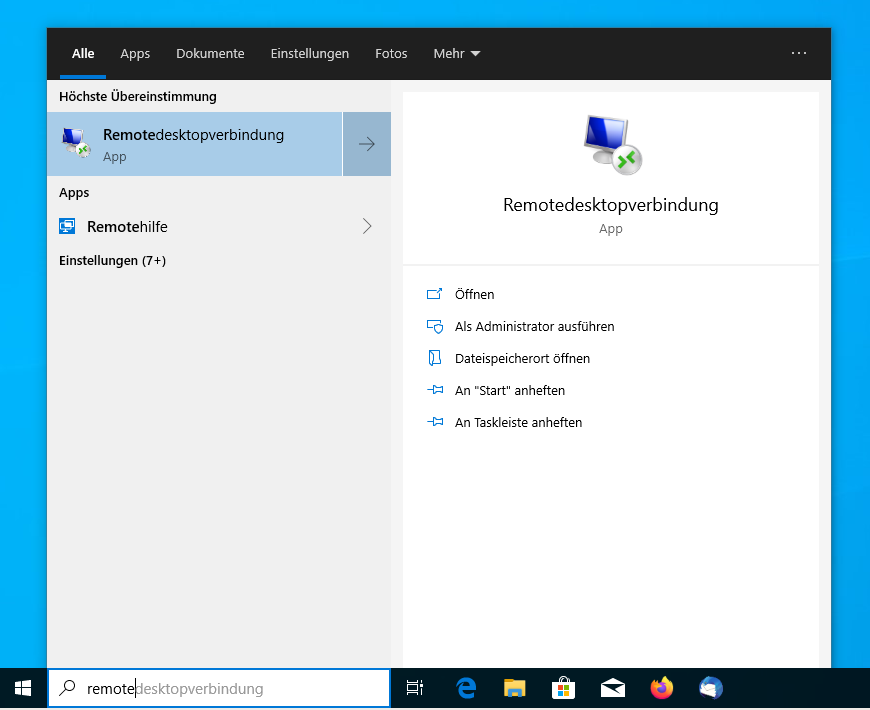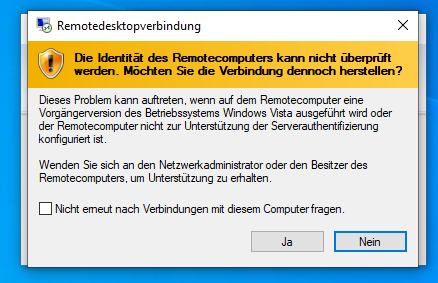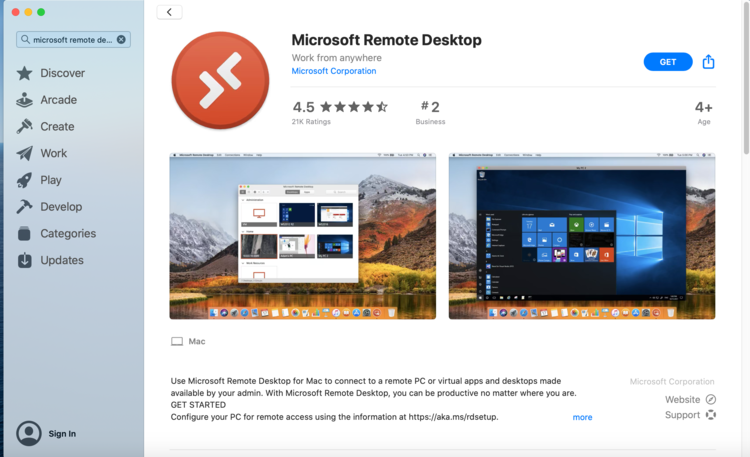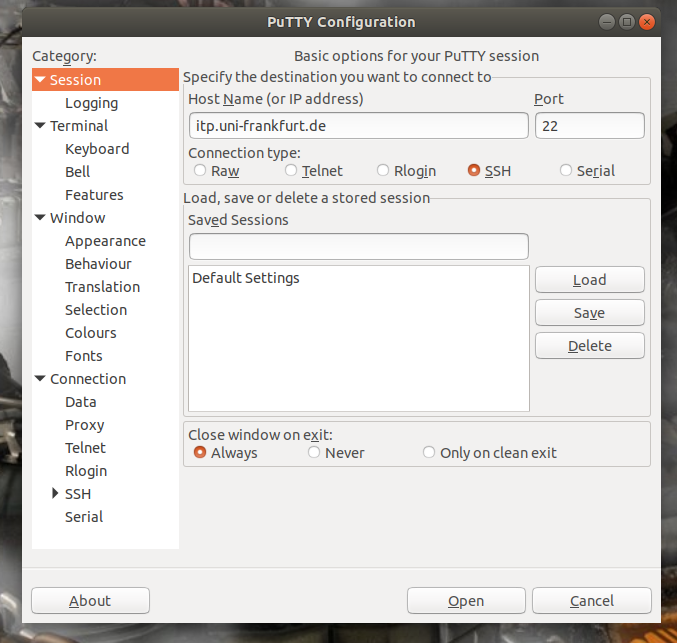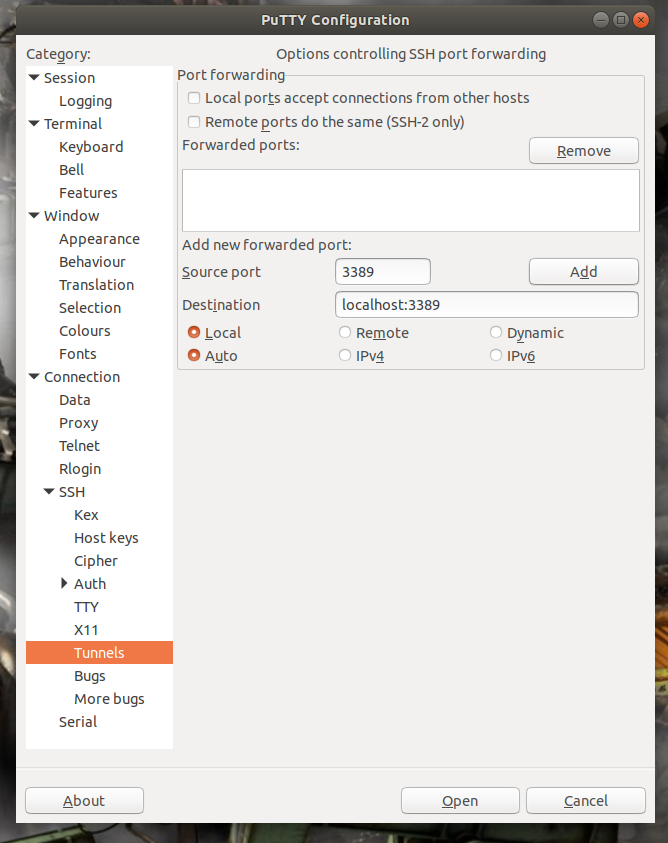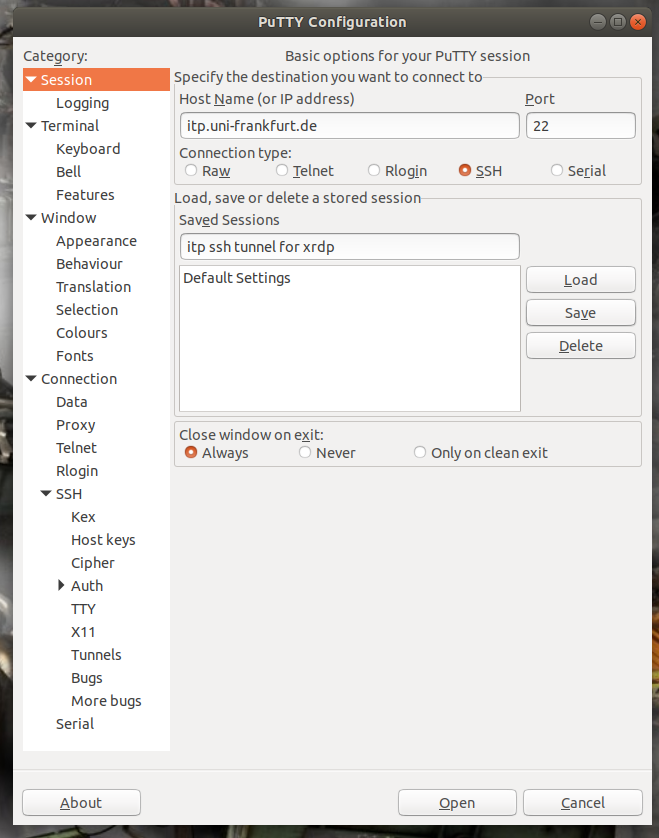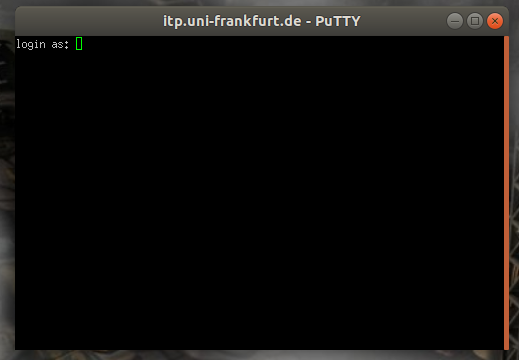Graphical Remote Login with xrdp
If you are using a Linux desktop system or Windows 10, then you can remotely login into a Linux session on our main login server zeta. For macOS this should work similar to Linux, but is not tested.
To use this service you either need to connect to the ITP VPN or need to establish a ssh-tunnel.
How to use the ITP VPN with openvpn is described in VPN Access and with Networkmanager in VPN with Networkmanager. For most Linux distributions cases we recommend NetworkManager.
We first describe the settings needed if the ITP VPN is used. A description for ssh-tunnel is further below. If you use a Linux operating system and did not already configure the ITP VPN, the configuration with ssh-tunnel is shorter. For MacOS and Windows10 we recommend using the ITP VPN.
If you disconnect from a xrdp session (on purpose or by a network error), you can reconnect to the same session in the next 36 hours. To completely end a session you need to log out inside of your xrdp session instead of interrupting the connection. All session, which are not connected for over 36 hours, are automatically terminated.
Contents
Set the window manager (Linux, macOS, Windows 10)
You can skip this section if you want gnome as your window manager of your remote login session.
The window manager cannot be set by a menu. Instead it is set bin the content of the file '.xsession' in your home directory of your ITP account. Most likely this file does not exist in your account. If you connect to xrdp without this file in your home directory, then (before starting the window manager) this file is created such that gnome is started as window manager.
You can manually override your '.xsession' to choose another window manager. Here is a list of supported window managers and which needs to be the content of the '.xsession':
gnome: gnome-session
kde: startkde
xfce: xfce4-session
lxsession: lxsession -s LXDE -e LXDE
Connect using remmina (Linux)
If it is not already installed on your system, install the xrdp client remmina (sudo apt-get install remmina). Other clients like vinagre should work to.
Before you can connect with remmina, you need to establish a vpn connection to the ITP or establish an ssh-tunnel (see further below).
Open remmina.
In remmina do not directly connect, as the connection does not work with the standard settings. Instead click on the plus sign in the upper left corner to set up the configuration for a new connection.
In the new window choose a 'Name' for your connection and in the line 'Server' you need to enter 'zeta'. Choose a custom resolution. You can also use the resolution of your client, but the performance decreases with very high resolutions.
In the section 'Colour depth' you eventually (depending on the version of remmina) need to choose another entry. The options 'GFX AVC444' and 'GFX AVC420' do not work. Choose one of the other options.
Next click on the 'Advanced' tab (only needed for new remmina versions).
Scroll down and check the option 'Glyph Cache'. If this option does not exist, you do not need to change anything in the 'Advanced' tab.
After saving your setting, you should have a new entry in your remmina main screen. Double click on this new entry to establish the xrdp connection.
After a few seconds you should get the following login screen.
Now you can log into a graphical session running on the login server zeta. This normally starts a gnome session. If you want another window manager please read the corresponding section on this page above.
Note: If you encounter connection problems with Remmina in recent Ubuntu Versions, specifying Username and Password in the configuration dialog skipps the login dialog. Do this only if you can trust your Linux installation.
Connect with Windows 10
For Windows 10 you eihter to establish a connection to the itp-vpn or establish a ssh-tunnel with Putty (for ssh-tunnel see further below).
The rest is very simple. In the window search menu search for 'remote'. In a german Window 10 you start the 'Remotedesktopverbindung' app. In english this should also begin with 'Remote desktop'.
In the next window enter 'zeta' as server (use 'localhost' instead of 'zeta' if you are using a ssh-tunnel). Under options you can change various things as the wanted resolution. But the standard setting also work. If the performance is to slow, try reducing the resolution in the options.
You can click yes in the next window.
Now you should get a login screen where you can log in with your itp account (see the Linux section above for a picture of the login screen).
Connect with MacOS
Go to the AppStore and search for 'Microsoft Remote Desktop'.
Install and start it. Adding a connection should be similar as in Linux with Remmina.
SSH-Tunnel instead of VPN
Instead of VPN you can also tunnel port 3398 to establish a connection to the xrpd server.
Terminal based ssh-tunnel
Just open a terminal and enter 'ssh -L 3389:localhost:3389 yourusername@itp.uni-frankfurt.de', where 'yourusername' needs to be replaced by your itp username. After a successful connection, do not close the terminal as else the ssh-tunnel is closed. In your client software (e.g. remmina) use as server 'localhost' instead of 'zeta'.
ssh-tunnel in remmina
Instead of using the ITP VPN, you can add an ssh-tunnel directly in remmina. For this first change the server from 'zeta' to 'zeta.itp.uni-frankfurt.de'.
Then in the connection menu switch to the tab 'SSH Tunnel'. Check the box 'Enable SSH tunnel', check 'Same server at port 22', enter your itp username at 'User name' and check 'Password'. Now, before connecting to xrdp, a ssh-tunnel is established where you need to enter your itp password. If you use ssh-keys to establish connection, you need to change the authentication method.
Putty
If you use a ssh-tunnel with Putty, then change in your client software (e.g. remmina) the server 'zeta' to 'localhost'.
Install Putty through your software manager or for Windows go to https://www.putty.org/ follow the link and download and install Putty.
After opening Putty enter 'itp.uni-frankfurt.de' in the 'Host Name (or IP address)' field.
On the left side extend at the bottom the menu 'SSH' and go to the submenu 'Tunnels'. Add '3389' as 'Source port' and 'localhost:3389 as 'Destination'. Then click on 'Add'.
Go back back to the previous menu by clicking on 'Session' in the upper left corner. Under 'Saved Sessions' choose a session name of your liking and click on 'Save'. Later you can reload your settings by selecting the session name and clicking on 'Load'.
To establish your connection click on 'Open'.
You should get a login screen for your ssh-tunnel where you log in with your itp account. If you close this window, the ssh-tunnel is terminated.
Now start your client for the xrdp connection (remember to change 'zeta' to 'localhost' in your client settings).
Restrictions
All sessions have a Idle time out, which is 36 h for now. You need to connect to your sessions at least once per day. Otherwise the sessions is killed. This is to prevent overloading of the server with stale remote sessions.
